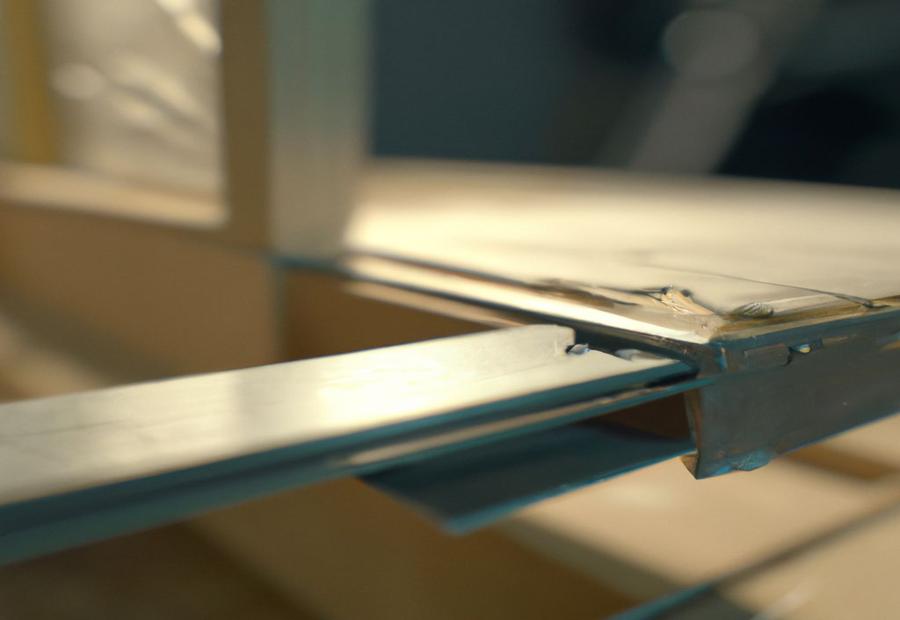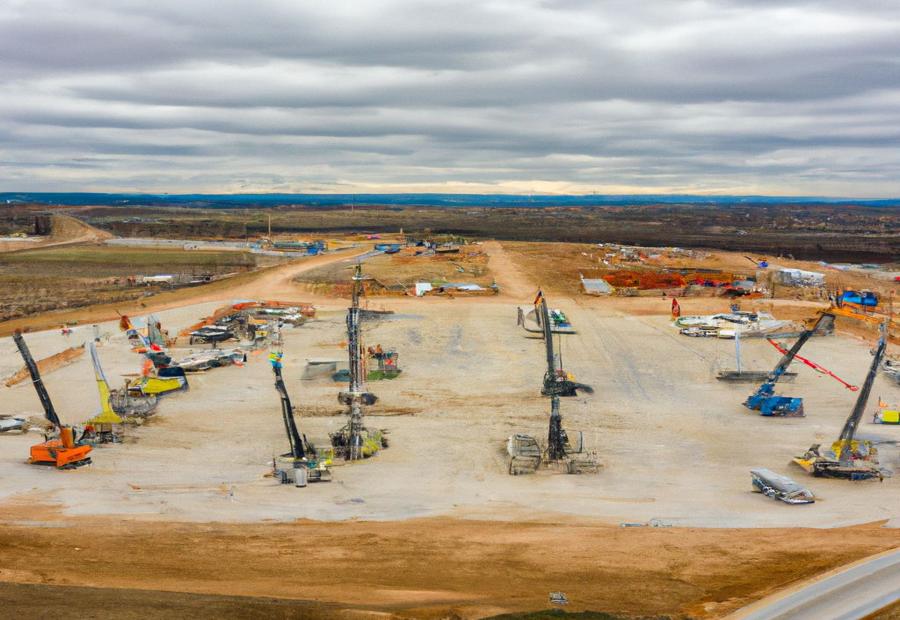Key Takeaway:
- Understanding the history of American Construction is important in order to appreciate the evolution and significance of the industry.
- The guild system, which originated in medieval Europe, played a significant role in shaping construction practices and techniques.
- The construction industry in the American colonies was heavily influenced by European construction techniques and materials.
- The Industrial Revolution brought about technological advancements that revolutionized the construction industry and introduced new materials and techniques.
- The 18th to 19th century witnessed the expansion of infrastructure projects and urban development, with specific construction methods and techniques being utilized during this period.
- The construction industry faced challenges and underwent significant developments during the Civil War era, with the war itself impacting construction activities.
- The post-Civil War period saw the role of construction in America’s economic growth, with various projects and initiatives being undertaken.
- Modernization and innovations in the construction industry introduced new materials, techniques, and technological advancements.
- The 20th century was marked by the impact of World Wars and economic booms on the construction industry, leading to numerous activities and projects.
- The current trends and future prospects of the American construction industry include advancements in technology and sustainable construction, while also posing challenges and opportunities.
- Reflecting on the evolution and significance of American construction allows for a deeper understanding of the industry’s history and its impact on society.



Photo Credits: Build-Wire.Com by Joe Wilson
Dive into the intriguing history of American Construction as we explore its key periods and developments. Gain a deeper understanding of the importance of studying this history and its implications in today’s construction industry. Get ready to embark on an enlightening journey as we delve into the fascinating stories behind the evolution of American Construction, backed by reliable sources and notable events.
Importance of understanding the history of American Construction
Grasping the history of American Construction is vital for a number of reasons. Exploring the evolution of construction practices and techniques gives us valuable insights into how the industry has developed over time. This helps us to build on successes and learn from challenges faced by predecessors. Consequently, we can create more effective construction strategies now.
A closer look at history reveals significant advancements and milestones in each period. Medieval Origins of Construction Guilds in Europe, Industrial Revolution, and Technological Advancements have all shaped the industry. We can see how changes in technology, materials, and societal needs have impacted construction practices throughout history.
Each period has its own unique details that are important to understand. For instance, during post-Civil War Reconstruction and Infrastructure Expansion, construction was key to economic growth. Nowadays, innovations have brought new materials and techniques, altering the construction industry. By exploring these aspects in depth, we can gain a deeper understanding of how American Construction has changed.
Overall, comprehending the history of American Construction gives us a base to continue building and innovating. We can use it to learn from successes and failures, while appreciating the progress made in the industry. Plus, studying historical trends gives us insights into potential future directions for construction practices. This helps us to adjust to emerging technologies and sustainable construction methods efficiently.
Overview of key periods and developments in American Construction
European construction guilds had a major effect on construction techniques. They trained and organized craftsmen, passing down knowledge and expertise. This set the stage for American construction progress.
European settlers brought their methods and supplies to the American colonies. Traditional materials such as timber and brick were used, plus new techniques were introduced, like timber framing and plastering. This shaped American building design.
The Industrial Revolution changed the construction industry. Steam power and mass production made infrastructure projects and cities develop faster. Cast iron and steel were also added.
The Civil War caused damage to buildings and infrastructure. Construction companies had various difficulties, but were key to rebuilding the US.
World Wars I and II increased the demand for military structures. This drove technological advances in building materials.
The Medieval Origins of Construction Guilds



Photo Credits: Build-Wire.Com by Ralph Robinson
The medieval origins of construction guilds reveal the rise of the guild system in Europe and how it profoundly influenced construction practices and techniques. Delve into the fascinating history of these guilds and discover their lasting impact on the evolution of American construction.
Rise of the Guild System in Europe
Guilds had a powerful effect on the construction industry in Europe. They were professional organizations of skilled craftsmen, like masons and carpenters, to protect their interests. These guilds kept standards high and trained new members in the trade.
Guilds had a huge impact on construction. They ran formal apprenticeship programs to teach young people the craft. They also had strict codes of conduct and regulations to maintain quality. This prompted the development of new building methods and techniques.
Guilds encouraged collaboration among craftsmen, with knowledge sharing and innovation at meetings and discussions. This fostered a sense of camaraderie and mutual support.
Guilds regulated entry into the profession, ensuring only qualified individuals could practice a trade. They gave their members exclusive rights to market their services in a certain area.
Overall, guilds standardized construction practices and promoted innovation, collaboration, and professionalism within the trade. Even today, these influences can be seen in modern construction organizations.
In the construction world, guilds wielded unstoppable influence, forming practices and techniques with their medieval might.
Influence of guilds on construction practices and techniques
Guilds in Europe, during the Medieval period, had great influence on construction. They were groups of skilled workers with specific trades, including construction. These guilds formed the development of construction methods and helped create new ideas.
Guilds shared knowledge and skills to apprentices. This kept craftsmanship high and made construction safer and durable. They also set standards for quality of materials and workmanship. This raised the level of professionalism within the construction industry.
Guilds provided support to their members. They gave financial help, promoted competition, and supported collaboration between different trades. This helped share ideas and made more advancements in construction.
Guilds still influence construction today. Timber framing and masonry techniques are examples that originated from this period. Also, the importance of craftsmanship that guilds taught still remains a cornerstone of the construction industry.
Construction in the American Colonies



Photo Credits: Build-Wire.Com by Gregory Wright
In the fascinating realm of construction in the American colonies, we delve into the influences of European construction techniques and the methods and materials used during that time. Discover how the knowledge brought by the early settlers and their rich cultural background shaped the foundations of American construction.
Influence of European Construction Techniques
European construction techniques had an immense effect on the growth of American construction practices and techniques. In colonial times, European architectural styles, like Georgian and Gothic Revival, were the models for numerous structures. European craftsmen and builders brought their experience and knowledge to America, and this made the construction industry improve.
Guilds from medieval Europe also had a huge influence on American construction procedures. Apprenticeship programs were the focus of these guilds, to make sure people got hands-on experience before they became experts in their trades. This concentration on skill development and following standardized practices impacted construction in the colonies.
European construction techniques also introduced new methods and materials to the colonies. Timber-framing was an example, which was popular in Europe and then modified to fit local conditions in America. This allowed for fast assembly and disassembly, ideal for temporary settlements during colonization. Materials such as brick and stone were either imported from Europe or produced locally using European methods.
In conclusion, the influence of European construction techniques on early American construction is undeniable. These influences impacted not only the physical structures, but also the skills and knowledge passed on through generations of American craftsmen. Knowing this history is important for recognizing the development of American construction practices and techniques over time. The American colonies laid the foundations for the construction industry’s evolution, creating a new nation with old-world techniques.
Construction methods and materials used in the American Colonies
The construction methods and materials used in the American Colonies were greatly influenced by European techniques. Timber framing and wattle and daub were popular methods, while wood, stone, and clay were abundant resources. This is summarized in the following table:
| Construction Methods | Materials |
|---|---|
| Timber Framing | Wood |
| Wattle and Daub | Clay, straw, and branches |
| Stone Masonry | Stone |
These methods utilized local resources to create robust structures. Half-timbered houses with infill panels made of brick or stone were unique features. By combining European techniques with innovative solutions, the colonists adapted to their surroundings. The Industrial Revolution propelled American construction into a new era of innovation and ambition.
Industrial Revolution and Technological Advancements



Photo Credits: Build-Wire.Com by Randy Johnson
During the Industrial Revolution, the construction industry experienced a significant shift due to the advancements brought about by technological innovations. This section explores the impact of industrialization on construction and delves into the introduction of new technologies and materials that revolutionized the way buildings were constructed. Discover how these changes shaped the landscape of American construction and paved the way for modern construction practices.
Impact of Industrialization on the Construction Industry
Industrialization had a major effect on the American construction industry. It changed from manual labor to mechanized processes and mass production. This transformation completely revolutionized construction, making it faster and more productive.
New machinery and technologies allowed companies to finish projects quicker and on a larger scale. For example, steam-powered engines made cranes and excavators possible, enabling the construction of tall buildings and complex structures.
In addition, industrialization brought new materials into construction, like iron and steel. These provided more stability and strength, so architects could design ambitious projects.
The division of labor also changed. Instead of workers doing all aspects of a project, they focused on one job. This specialization improved efficiency, but also raised worries about safety and conditions.
Introduction of new construction technologies and materials
The story of American construction is a tale of ever-changing technologies and materials. From the old-world Guilds, to the Industrial Revolution, each period has shaped today’s practices.
Guilds in Europe pioneered construction methods and materials, such as stone vaulting and timber frames. Settlers then brought this knowledge to the American colonies, constructing log cabins and timber-framed houses. Lime mortar was also used, leading to distinct colonial architecture.
The Industrial Revolution saw many advances in machinery, process, and infrastructure. Steel was a popular choice of material due to its strength and durability. Concrete and glass also became widely used, allowing for quicker construction and innovative design. Steel’s use increased in the 19th century, with iconic structures such as the Brooklyn Bridge.
Construction in the United States from the 18th to 19th Century



Photo Credits: Build-Wire.Com by Keith Robinson
Construction in the United States during the 18th and 19th century witnessed remarkable expansion of infrastructure projects and urban development. From revolutionary construction methods to innovative techniques, this era shaped the landscape of American architecture. Discover how ambitious projects and skilled craftsmanship helped propel the nation forward, transforming cities and building the foundations of progress.
Expansion of Infrastructure Projects and Urban Development
The growth and progress of America was significantly shaped by the expansion of infrastructure projects and urban development throughout its history. From the 18th to 19th century, to the post-Civil War era, construction activities focused on growing cities, building roads, bridges, and other essential infrastructure. This improved transportation networks, connected different regions, and created prosperous cities.
Industrialization and population growth during the 18th to 19th century called for infrastructure projects. Canals, railways, and bridges were built to boost trade and transportation. Urban development also saw the rise of factories and mills.
After the Civil War, the focus shifted to rebuilding the nation’s infrastructure. Reconstruction projects involved the repair of damaged structures and the building of roads, railroads, schools, hospitals, and government buildings.
The most notable example of the expansion of infrastructure projects is the transcontinental railroad. It connected the east coast to the west coast and revolutionized travel and trade. Thousands of workers faced harsh conditions and geographical obstacles to build this railroad.
The expansion of infrastructure projects over the years has had a lasting effect on America’s development. It has been a key factor in making America the urbanized and connected nation it is today.
Building America, one brick at a time – re-discovering the construction methods and techniques of the past!
Construction methods and techniques used during this period
Construction methods in the 18th and 19th centuries were influenced by the growing American infrastructure. Cities needed more buildings and infrastructure, which led to new construction methods.
Timber framing and masonry were popular. Timber framing meant using wooden beams and posts for structure. Masonry used stone or brick walls. These techniques were used for residential and commercial buildings.
Balloon framing was a new technique. It used lightweight wooden studs that could be assembled easily on-site. Cast iron construction allowed for taller buildings with stronger support.
New materials also changed construction methods. Iron and steel let us use metal-framed structures. Reinforced concrete gave us strength and design versatility.
In conclusion, American construction methods during this period were a mix of traditional European practices and innovative technology and materials. This set the stage for future construction advancements.
The Construction Industry during the Civil War Era



Photo Credits: Build-Wire.Com by Frank Hall
The Construction Industry during the Civil War Era was characterized by key developments, challenges faced by construction companies, and the significant impact of the Civil War on construction activities. From technological advancements to the shifting workforce, this era witnessed a transformation that shaped the future of American construction. Explore the fascinating history and implications of this pivotal time in our nation’s construction industry.
Key Developments and Challenges Faced by Construction Companies
Construction companies have faced various key developments and challenges throughout history. So much so, that the industry has been shaped by them.
During the Medieval period in Europe, guilds rose up, influencing construction practices and techniques. This was to maintain standards. As construction techniques evolved, companies were challenged to adopt new methods and materials.
In the American Colonies, European practices heavily influenced their construction techniques. The use of timber framing and stone masonry was common. But, the lack of resources posed challenges, forcing adaptations to suit the local environment.
The Industrial Revolution had a profound impact on the construction industry. Steam-powered machinery and materials such as iron and steel revolutionized construction processes. Companies had to adapt to these new technologies and integrate them into their operations.
The 18th to 19th century saw a significant expansion in infrastructure projects and urban development in the US. This offered both opportunities and challenges for companies. They had to find ways to meet increased demand and navigate complex logistical issues.
The Civil War brought about further developments and challenges. Labor shortages caused by men enlisting in the military, along with an increased demand for fortifications and military infrastructure, meant companies had to overcome obstacles.
Post-Civil War reconstruction provided growth opportunities for the construction industry. However, companies were challenged with funding and coordinating large-scale projects effectively.
In modern times, technology continues to shape the construction industry. Innovative materials like reinforced concrete or composite building materials have allowed for more efficient construction processes. Companies must stay up-to-date and incorporate sustainable construction methods.
Throughout the 20th century, world wars and economic booms caused fluctuations in the construction industry. Companies had to navigate these changes and adapt their strategies. Government investments in infrastructure had a significant influence on the growth of the sector.
Looking ahead, the American construction industry faces both opportunities and challenges. Technology offers potential for increased productivity and efficiency. However, companies must also address sustainability and environmental impact. Additionally, labor shortages and regulatory requirements will shape the industry’s future.
The Civil War had a devastating impact on construction activities, showing that the real battle wasn’t just fought on the battlefield, but on building sites too.
Impact of the Civil War on construction activities
The Civil War had a great effect on US construction. Much of the fighting happened in the South, leading to destruction of many buildings and infrastructure. This increased the need for reconstruction.
Construction companies faced big challenges. Resources and labor were scarce, and many skilled workers were taken or killed in battle. This worsened the labor shortage.
The war brought changes to construction techniques. Builders used prefabricated components and standardized designs to speed up the process.
The Civil War also created opportunities. More infrastructure was needed for post-war rebuilding, creating job openings in construction.
The impact of the Civil War was both destructive and transformational. It caused damage but also spurred innovation in building techniques. New standards of efficiency and speed were set. Advanced tech and materials were used which helped shape future American construction.
Post-Civil War Reconstruction and Infrastructure Expansion



Photo Credits: Build-Wire.Com by Robert Lee
Following the devastation of the Civil War, America witnessed a period of post-war reconstruction and an unprecedented expansion of infrastructure. In this section, we explore the pivotal role that construction played in driving the nation’s economic growth during this era. Additionally, we delve into the various construction projects and initiatives that were undertaken as part of the post-Civil War efforts to rebuild and modernize the country’s infrastructure.
The Role of Construction in America’s Economic Growth
The construction industry has been key to America’s economic growth. From when Europeans colonised in the past to now, construction has helped develop and increase the country’s infrastructure. New techniques and materials, and large-scale projects, have had a great effect on America’s wealth.
In colonial times, American construction methods were based on European ideas brought by settlers. This can be seen in the architecture and building methods used. As the colonies developed, construction was hugely important in creating towns, cities and trade networks, which all aided economic growth.
The industrial revolution saw big changes in construction. Machines, steel and concrete meant that bigger, more complex structures could be made faster. This meant more infrastructure projects, urban development, and economic growth.
The Civil War caused labour shortages and other problems. After the war, construction firms had the chance to help rebuild and expand infrastructure. This gave a boost to the economy.
World Wars 1 and 2 had a big effect on America’s economy and the construction industry. During the war, there was a need for more infrastructure, and post-war reconstruction added to this. This triggered construction activities, creating jobs, and growing the economy.
Technology will continue to shape the American construction industry. BIM systems, drones for surveying and monitoring, and sustainable construction can all help. Challenges such as workforce shortages and changing regulations must also be tackled, to keep the industry helping the economy.
Construction projects and initiatives during the post-Civil War period
Right after the Civil War, America embarked on a range of building projects and initiatives. Their goal? To rebuild and expand the nation’s infrastructure. Roads, bridges, railroads and buildings were all constructed. Such projects helped with economic growth and the development of the country.
The Civil War had taken a heavy toll, so there was an urgent need to modernize different aspects of American life. These construction projects hoped to reconnect war-torn regions, better transportation networks, and support economic growth. For example, they built the Transcontinental Railroad that joined the Atlantic and Pacific coasts of the U.S. Cities like New York’s Central Park were also created to provide green spaces.
The post-Civil War period saw a commitment to rebuilding and progress in the U.S. These efforts formed a solid base for further development in later years. They not only improved infrastructure, but also had a major influence on the future of American society and economy.
Modern materials and state-of-the-art techniques are transforming the construction industry. This is a roadmap to progress.
Modernization and Innovations in the Construction Industry



Photo Credits: Build-Wire.Com by Thomas Torres
Modernization and innovations have revolutionized the construction industry, introducing new materials, construction techniques, and technological advancements. Discover the impact of these developments on construction practices and how the introduction of new materials and techniques has shaped the industry. Explore how the latest technologies have paved the way for unprecedented efficiency, safety, and sustainability in the construction field.
Introduction of New Materials and Construction Techniques
The construction industry has always welcomed new materials and techniques. Over time, significant periods of innovation and technological advances have transformed building construction. Medieval guilds regulated and trained craftsmen, allowing knowledge of creative materials and techniques to spread. In the American colonies, European construction techniques were a major influence.
The Industrial Revolution brought forth machinery, like steam engines and power tools, altering material production and construction processes. Cast iron, steel, and concrete became popular, offering greater strength and durability. Balloon framing (a lightweight wooden technique) was introduced in the 18th-19th century US, alongside transport advancements.
For professionals in the industry, staying updated is important for professional growth. New materials and techniques will continue to shape its future. By embracing these innovations, professionals can take on the challenges and opportunities coming their way. Technology, like drones and 3D printing, is shaking up construction like a toddler with a sandcastle.
Impact of technological advancements on construction practices
Throughout time, technology has had a huge effect on construction. From the Industrial Revolution to today’s inventions, new tech has modernized how projects are planned, designed, and executed.
In the Industrial Revolution, steam power and mechanized tools sped up projects and improved productivity. Recently, CAD has changed how projects are designed and built. It helps architects and engineers make 3D models that can be checked before building starts. This saves time and stops errors.
BIM is a digital model of a building’s features. It lets stakeholders share data and coordinate tasks. This increases efficiency.
Plus, tech advancements have changed the materials used in construction. Reinforced concrete and steel are now stronger and more durable. They let buildings be taller with bigger open spaces.
The 20th century shaped the American construction industry with tech advancements. These advancements have led to increased efficiency, better safety, and the ability to take on complex projects.
Construction Industry in the 20th Century



Photo Credits: Build-Wire.Com by George Moore
In the 20th century, the construction industry witnessed significant transformations shaped by historical events and economic conditions. Explore the impact of World Wars and economic boom on construction, as well as the diverse activities and projects that marked this era. From wartime construction efforts to booming economies driving infrastructure development, this section uncovers the dynamic landscape of the construction industry throughout the 20th century.
Impact of World Wars and Economic Boom on Construction
The effect of the World Wars and Economic Boom on the construction industry in America was huge. These major events had a noticeable effect on the demand for construction, causing a rise in infrastructure development and rebuilding projects.
WWI and WWII led to a focus on military infrastructure. The urgency of the wars demanded the building of army bases, airfields, and defense facilities faster than ever before. This helped construction techniques and technologies to advance quickly to meet the military’s needs.
The economic boom that followed the wars further drove the growth of the construction industry. The post-war era saw a lot of urban development with the constructing of housing developments, commercial buildings and public infrastructure projects. Government funding and increased consumer spending provided the push the construction sector needed to expand.
Plus, this period saw a move towards industrialization, with new industries such as manufacturing and transportation popping up. These industries required specialized construction for factories, warehouses and transportation networks to enable their growth.
The impact of the World Wars and Economic Boom can still be seen in the infrastructure that was built during that time. Professionals in the industry need to understand this history to recognize the growth of American construction practices.
Construction activities and projects during the 20th century
The 20th century saw many construction projects transform the US landscape. Economic growth, population increase, and tech advancements drove a boom in infrastructure and urbanization.
Highways, bridges, and railways were built to meet the nation’s needs. The Hoover Dam and Golden Gate Bridge showcased US engineering and tech.
Reinforced concrete and steel framing revolutionized building. Modular construction enabled faster completion and cost savings.
Two World Wars had a big effect on construction. Military bases, airfields, and defense installations were made to support operations. Post-war efforts focused on rebuilding infrastructure damaged in combat.
The Great Depression saw public works initiatives like the TVA dam system bring electricity to rural areas and create jobs.
Overall, the 20th century was a period of progress and modernization which reshaped skylines and advanced the economy and society. Cutting-edge American construction now paves the way for sustainable innovations.
Current Trends and Future Prospects of the American Construction Industry



Photo Credits: Build-Wire.Com by Austin Hall
The current trends and future prospects of the American construction industry reveal exciting advancements in technology and sustainable construction practices. As we explore this topic further, we will also uncover the opportunities and challenges that lie ahead for the industry. From cutting-edge innovations to potential growth areas, this section will highlight the key factors shaping the future of construction in the United States.
Advancements in Technology and Sustainable Construction
Technology and sustainable construction have been major players in shaping the American construction industry. New materials and methods used throughout history have revolutionized building design and construction. For instance, the Industrial Revolution brought about huge tech advancements, allowing for speedier and more efficient processes.
Sustainability has become an important topic recently, as reducing environmental impact and promoting energy efficiency in buildings has gained prominence. It looks like the future of the American construction industry is a bright one, as technology and awareness of sustainability continue to advance.
Throughout history, tech has had a big impact on construction in America. From mechanized equipment during the Industrial Revolution, to modern tools like BIM, tech has pushed boundaries and improved efficiency. Plus, it has made project management easier through software solutions connecting different stakeholders.
Concerns about climate change and environmental impact mean that sustainable construction practices have been a focus recently. Materials like recycled steel and reclaimed wood are being used more, while green building certifications like LEED are popular. In addition, innovations like solar panels and energy-efficient insulation systems enable buildings to generate renewable energy and optimize energy usage.
As we look to the future of the American construction industry, tech will continue to shape how buildings are designed, constructed, and operated. AI and automation may improve productivity and cost-effectiveness. Furthermore, the focus on sustainable construction methods is likely to grow, with stricter regulations and greater demand for eco-friendly buildings. By embracing these advances and employing sustainable construction techniques, the industry can strive for an efficient, environmentally friendly, and resilient future.
Opportunities and challenges in the future of the construction industry
The near future of the construction industry brings both chances and difficulties. Technological progress, such as different materials and building techniques, offer a way to upgrade productivity and sustainability. The growing request for sustainable building practices provides companies a chance to stand out. However, these advancements bring troubles too, like needing to learn and use new technologies. The industry must find a way to manage these opportunities and challenges so they can remain competitive and meet clients’ changing needs.
Moreover, with increased attention on sustainability, there is a potential to incorporate eco-friendly practices into projects. This includes using renewable materials, energy-efficient designs, and green building certifications. Companies can appeal to eco-conscious buyers and help create a greener future by embracing sustainability. Though, this shift may require lots of R&D and changes in business models.
In the future, yet another difficulty is tackling the lack of skilled labor. With an aging workforce and fewer young people wanting construction jobs, there is an urgent need to employ and teach new talent. Leaders must introduce strategies to promote vocational education programs, apprenticeships, and mentorship initiatives to develop an experienced workforce.
It’s essential for stakeholders in the construction industry to be aware of these chances and problems. Companies can become successful by embracing tech and sustainable practices, while addressing labor shortages with innovative recruitment strategies. Failing to adapt may lead to missed opportunities or being left behind. Companies need to keep up with trends and take action toward embracing change and making sure long-term success.
Conclusion: Reflecting on the Evolution and Significance of American Construction



Photo Credits: Build-Wire.Com by Bobby Hall
Reflecting on American construction, it’s clear that this industry has had a huge impact on US history and infrastructure. The reference data shows us the long timeline of the industry, from its developments and innovations to its iconic landmarks.
The Empire State Building and the Golden Gate Bridge are just two of the many examples of American construction, which demonstrate the engineering prowess and ambition of the country.
American construction has also been a huge economic driver, creating jobs and stimulating other industries such as manufacturing and transportation. It has also constantly strived for efficiency and sustainability with the introduction of new materials and building methods.
Some Facts About Dive into the History of American Construction:
- ✅ Construction put-in-place in the U.S. ended at a rate of $1.24 trillion, 1.4% higher than the previous estimate. (Source: Team Research)
- ✅ National average construction costs increased by approximately 4.22% between October 2016 and October 2017. (Source: Team Research)
- ✅ San Francisco and Los Angeles saw the greatest increases in construction costs (7.63% and 7.08% respectively), while Chicago, Portland, and Seattle saw more modest increases ranging from 5.21% to 5.76%. (Source: Team Research)
- ✅ Construction activities in Canada gained momentum, with a 3.5% increase in the value of building permits in October 2017. (Source: Team Research)
- ✅ Historic houses in Wisconsin were built using log construction, timber frame, or wood frame techniques, with different building methods and materials used in each. (Source: Wisconsin Historical Society)
FAQs about Dive Into The History Of American Construction
FAQ 1: What is the historical evolution of the American construction industry?
The book “The American Construction Industry: Its Historical Evolution and Potential Future” provides a comprehensive resource tracing the development of the construction industry from its origins in the medieval guild system to the modern high-tech jobsite.
FAQ 2: What are the different types of historic wood house construction?
Historic wood houses in Wisconsin were built using log construction, timber frame, or wood frame techniques. Log construction involved laying logs horizontally and filling gaps with mud, clay, and straw. Timber frame construction used hand-hewn logs assembled with wood joinery. Wood frame houses were built with uniform, dimensional lumber and had wood siding, trim, and shingles.
FAQ 3: What were the framing techniques used in wood-framed houses?
There were two framing techniques used for wood-framed houses. Balloon framing consisted of stud walls that extended from the foundation to the roof rafters, creating a fire hazard. Platform framing, introduced in 1920, made each story independent and safer in case of a fire.
FAQ 4: What are the key characteristics of historic masonry houses?
Historic masonry houses were built with solid brick, stone, or concrete walls on a masonry foundation, with wood-framed flooring and roof. Masonry veneer houses had a wood frame with a layer of brick, stone, or stucco attached to the exterior walls.
FAQ 5: How have historic houses and the materials used changed over time?
Historic houses often have original old-growth wood in flooring, structural materials, trim, siding, windows, doors, and cabinetry. After 1940, old-growth lumber was not available for house construction, and today’s lumber is made from younger trees. Lumber sizes have also changed over time, with dimensional lumber sizes shrinking since the 1930s.
FAQ 6: What are the key findings of the RLB Quarterly Construction Cost Report?
The RLB Quarterly Construction Cost Report tracks construction costs in 12 American cities and two Canadian cities, providing a market-by-market look at construction costs. It surveys specific construction sectors, identifies low and high construction costs in each urban center, and equips clients with complete and relevant information for key business decisions.
